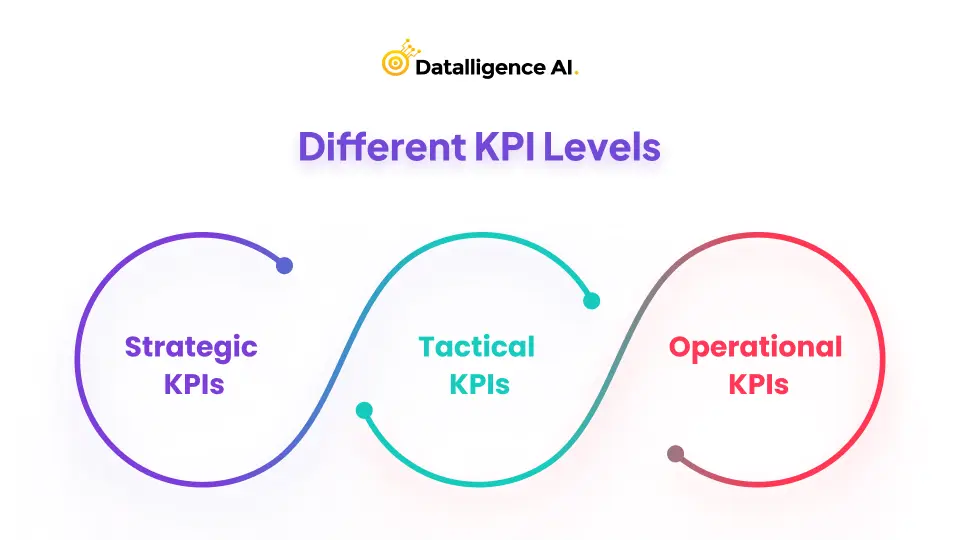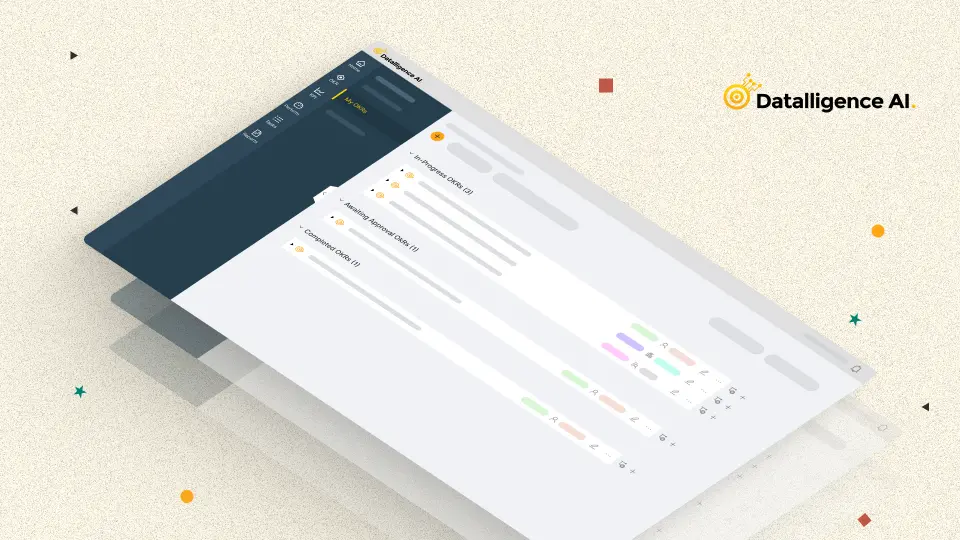What is KPI
KPIs (Key Performance Indicators) are measurements used to evaluate the success of an organization or individual in achieving their objectives. Tracking KPIs is crucial for several reasons:
Performance evaluation: KPIs provide a clear picture of how an organization or individual is performing in terms of achieving their goals. This allows for more effective decision-making based on actual data rather than assumptions.
Goal setting and achievement: KPIs help to set achievable goals and measure progress towards those goals. This motivates them to work towards the desired outcome and ensures that the organization or individual stays on track.
Process improvement: KPIs can highlight areas that need improvement and help identify inefficiencies. By measuring and analyzing data, organizations can identify the root cause of a problem and implement solutions to improve processes.
Accountability: KPIs hold individuals and organizations accountable for their performance. Individuals and organizations can take ownership of their actions and outcomes by regularly tracking and reporting KPIs.
In summary, tracking KPIs is essential for monitoring progress, making informed decisions, identifying areas for improvement, and holding individuals and organizations accountable for their performance.
Some key points about KPIs are
- KPIs are specific, measurable, and time-bound indicators of performance.
- They help an `organization track progress toward achieving its goals and objectives.
- KPIs vary depending on the industry, the organization, and the specific objectives they are trying to achieve.
- KPIs can be used to measure different aspects of performance, such as financial performance, customer satisfaction, employee engagement, and operational efficiency.
- KPIs should be regularly reviewed and updated to ensure they remain relevant and practical.
Examples of KPIs:
- Sales revenue: This KPI measures the money generated through sales over a specific period.
- Customer retention rate: This KPI measures the percentage of customers who continue to do business with an organization over time.
- Employee turnover rate: This KPI measures the percentage of employees who leave an organization over a specific period.
- Website traffic: This KPI measures the number of visitors to a website over a specific period.
- Customer satisfaction score: This KPI measures customers’ satisfaction with an organization’s products or services.
How to define KPIs
Defining KPIs is a crucial step in the performance management process. Here are some steps to consider when defining KPIs:
Identify your business objectives 🎯
The first step in defining KPIs is to identify the key business objectives that you want to achieve. These objectives should be specific, measurable, achievable, relevant, and time-bound (SMART). Once you have identified your objectives, you can then start to think about the KPIs that will help you to measure progress towards these objectives.
Determine the metrics to measure 📈
Once you have identified your objectives, the next step is to determine the metrics that you will use to measure progress toward these objectives. The metrics should be relevant to your business objectives and should be easily measurable.
For example, if your objective is to increase sales revenue, then your metric could be the total amount of sales revenue generated over a specific period.
Set targets for each KPI 🎯
Once you have determined the metrics to measure, the next step is to set targets for each KPI. Targets should be specific, measurable, and achievable. They should also be aligned with your business objectives.
For example, if your objective is to increase sales revenue by 10% over the next quarter, then your target for your sales revenue KPI could be to increase sales revenue by 2.5% per month.
Establish data collection and analysis processes 📊
To measure your KPIs, you will need to establish data collection and analysis processes. This may involve collecting data from various sources, such as your CRM system, website analytics, or social media platforms. You will also need to analyze the data to track progress toward your targets.
Review and adjust KPIs regularly 🔄
Finally, it is important to review and adjust your KPIs regularly to ensure that they remain relevant and aligned with your business objectives. You may need to adjust your targets, metrics, or data collection and analysis processes based on changes in your business environment or performance. By regularly reviewing and adjusting your KPIs, you can ensure that they continue to provide valuable insights into your business performance.
What are the benefits of using KPI software?
There are several benefits of using KPI software to manage your key performance indicators. Here are some of the main advantages:
Increased efficiency and accuracy in data collection and analysis 📊
KPI software automates the data collection and analysis process, making it faster and more accurate. This means that you can spend less time manually gathering and analyzing data and more time focusing on making informed decisions based on the insights provided by the software.
Improved visibility into performance across the organization 👀
KPI software provides real-time visibility into performance across the organization, making it easier to identify trends and patterns that may be impacting overall performance. This allows you to quickly respond to issues and opportunities and make data-driven decisions that can help to improve overall performance.
Better alignment with business objectives 🎯
KPI software helps to ensure that your KPIs are aligned with your business objectives. This is because the software allows you to easily track progress towards specific goals and targets, and to adjust your KPIs as needed to ensure that they remain relevant and effective.
Increased accountability and transparency 💡
KPI software increases accountability and transparency by providing a clear and objective way to measure and report on performance. This helps to ensure that everyone in the organization is aware of their performance expectations and can work together to achieve common goals.
Improved communication and collaboration 🤝
KPI software allows for improved communication and collaboration by providing a centralized platform for sharing data and insights. This makes it easier for different teams and departments to work together and make informed decisions based on a shared understanding of performance.
Types of KPIs

KPIs, or Key Performance Indicators, are measurable values used to evaluate the success or progress of an organization or specific project. KPIs can be divided into different types based on their purpose and scope. Here are some common types of KPIs:
Financial KPIs
These KPIs are used to track an organization’s financial performance, such as revenue, profit, return on investment (ROI), and cash flow.
Operational KPIs
These KPIs are used to measure the efficiency and effectiveness of an organization’s operations, such as productivity, quality, cycle time, and capacity utilization.
Customer KPIs
These KPIs are used to measure customer satisfaction, loyalty, and retention, such as Net Promoter Score (NPS), customer churn rate, and customer lifetime value (CLV).
Sales and Marketing KPIs
These KPIs are used to track the effectiveness of sales and marketing efforts, such as lead conversion rate, sales growth, customer acquisition cost (CAC), and return on advertising spend (ROAS).
Human Resource KPIs
These KPIs are used to measure the performance of human resource management, such as employee turnover rate, training and development effectiveness, and employee engagement.
Environmental, Social, and Governance (ESG) KPIs
These KPIs are used to measure an organization’s performance in areas such as environmental impact, social responsibility, and corporate governance.
Health and Safety KPIs
These KPIs are used to measure an organization’s performance in ensuring the health and safety of employees, such as accident rate, injury frequency rate, and compliance with safety regulations.
Overall, KPIs can be customized to fit the specific needs and goals of an organization, and different types of KPIs can be combined to provide a more comprehensive view of an organization’s performance.
How to set KPIs for your team and company
Identify the objectives 🎯
Start by defining the overall objectives for your team or company. These objectives should be aligned with the organization’s mission and vision and should be specific, measurable, achievable, relevant, and time-bound (SMART). Once the objectives are clear, identify the critical success factors (CSFs) that need to be achieved to attain those objectives.
Define the KPIs 📊
Based on the CSFs, identify the key performance indicators (KPIs) that will help you measure progress toward achieving the objectives. KPIs should be meaningful and measurable, and they should provide insights into the performance of the team or company. Each KPI should have a target or threshold that needs to be achieved.
Involve the team
It is important to involve the team in the KPI-setting process. The team members should understand the objectives, CSFs, and KPIs and should be able to provide input on what KPIs would be most relevant and actionable for their specific roles. This will increase their buy-in and ownership of the KPIs.
Monitor and measure
Once the KPIs have been defined, set up a system to monitor and measure the KPIs regularly. This could involve collecting data, analyzing the data, and reporting the results to the team or company. It is important to track progress toward the targets and adjust as necessary to stay on track.
Take action 🚀
KPIs are only useful if they are used to drive action. Use the KPIs to identify areas where improvements can be made and take action to address any issues. It is important to communicate the results of the KPIs to the team or company and celebrate successes when KPIs are met or exceeded. Regularly review and refine the KPIs to ensure they remain relevant and meaningful to the team or company.
Different KPI Levels

There are generally three levels of KPIs:
Strategic KPIs
These are high-level KPIs that are directly linked to an organization’s strategic objectives. They are used to measure the overall performance of the organization and to track progress toward achieving its long-term goals.
Tactical KPIs
These are KPIs that are used to measure the performance of specific business units or departments within an organization. They are designed to help managers and team leaders identify areas where they need to focus their efforts to improve performance.
Operational KPIs
These are KPIs that are used to measure the day-to-day performance of individual employees or teams within an organization. They are typically focused on specific tasks or processes and are used to identify areas where productivity can be improved.
Overall, the level of KPI used will depend on the goals of the organization and the specific needs of each department or team within the organization. It is important to regularly review and update KPIs to ensure they remain relevant and aligned with the organization’s strategic objectives.
Best Sales KPIs
Sales Key Performance Indicators (KPIs) are important metrics that businesses use to track and evaluate their sales performance. Here are some of the best Sales KPIs that businesses can use to measure their sales effectiveness:
Sales Revenue
This is the total amount of revenue generated from sales in a given period. It is the most common KPI used to measure sales performance.
Sales Growth
This KPI measures the percentage increase or decrease in sales over a given period. It is an important metric that indicates how well a business is performing.
Customer Acquisition Cost (CAC)
This KPI measures the cost of acquiring a new customer. It is calculated by dividing the total sales and marketing costs by the number of new customers acquired in a given period.
Customer Lifetime Value (CLV)
This KPI measures the total amount of revenue that a customer is expected to generate over their lifetime. It is an important metric that helps businesses determine the long-term value of a customer.
Sales Conversion Rate
This KPI measures the percentage of leads or prospects that convert into paying customers. It is calculated by dividing the number of conversions by the number of leads or prospects.
To learn more about the best sales KPI, Visit our blog Top 6 Sales KPI
Conclusion
In conclusion, Key Performance Indicators (KPIs) are essential tools that help businesses measure progress toward achieving their objectives. To define KPIs, it’s crucial to start with the business goals, identify the metrics that align with those goals, and establish targets for those metrics. When setting KPIs for your team or company, it’s important to consider the KPI levels, including top-level, departmental, and individual KPIs. This ensures that everyone is aligned with the overall business objectives and has clear targets to work towards.
Talk to our coaches and experts and gain more insights or try “Datalligence” for free for 14 days.











